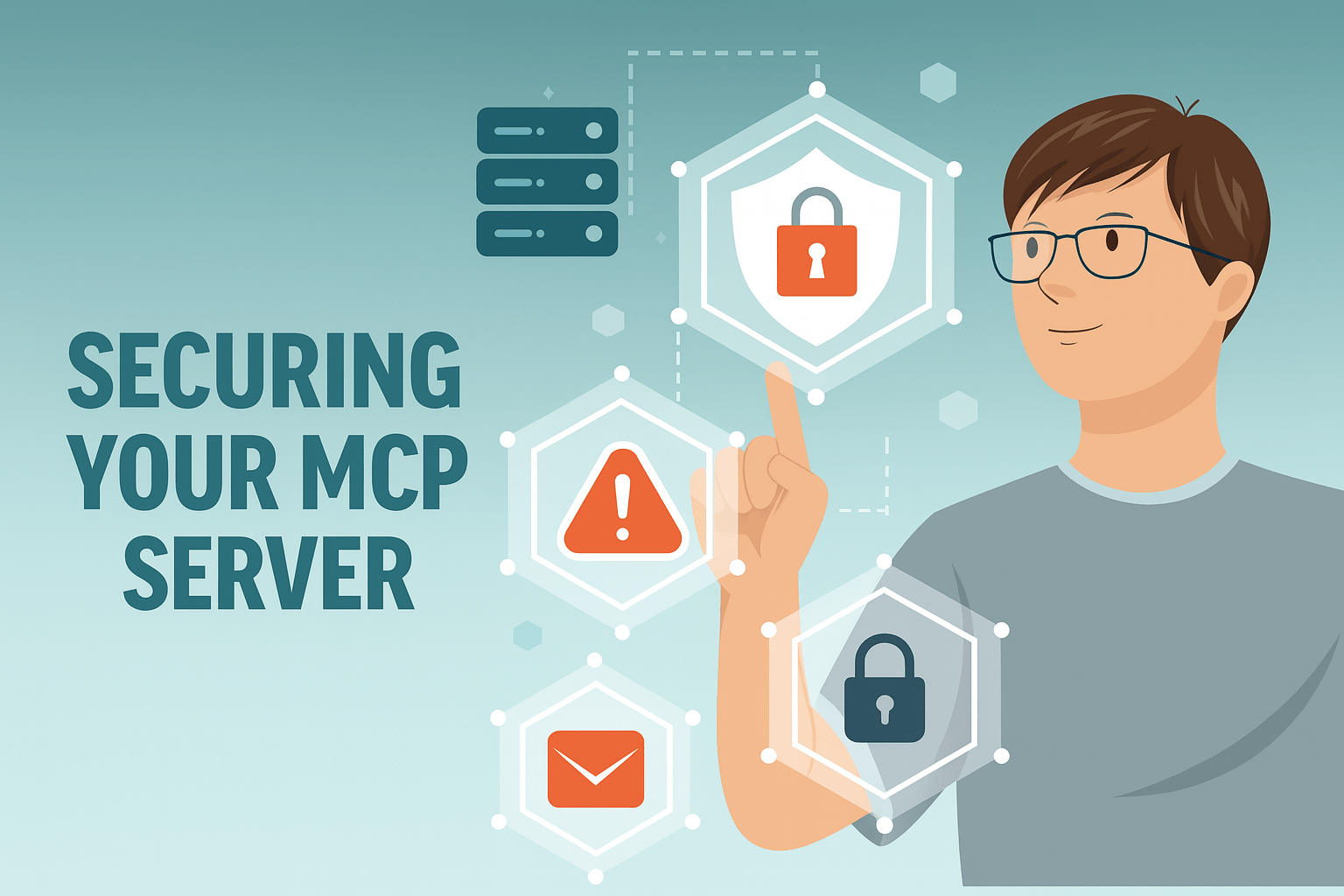
Table of Contents
In the fast evolving world of AI infrastructure, integrating tools and large language models (LLMs) through protocols like MCP (Model Context Protocol) can be transformative but without the proper safeguards, it can also become dangerously vulnerable. As organizations recognize the amazing potential of AI technology, a big question arises. Are your MCP server implementations sufficiently secure for sensitive data?
In this blog post, we will evaluate the types of vulnerabilities AI systems can experience, the methods attackers take advantage of them, and provide a comprehensive checklist to secure MCP server implementations. Whether you are working with LLMs, file systems, sensitive APIs, or any other use case that requires sensitive data, this guide provides actionable steps for improving your systems brought to you by the experts at NextGenSoft, just one of the experts making security first AI development one of our core values.
An Open Door for AI Can Be an Open Door for Attackers
LLMs ingesting and consuming real-time data and being used with external tools greatly enhance their capabilities. Your AI can now retrieve files, schedule commands, and communicate with other systems in more intelligent ways than ever before. This is great news for organizations, but it also presents massive risks if misconfigured.
Imagine your LLM integrated AI assistant that has access to a file system, and that connection is insecure. What is to stop a malicious user from telling the model to delete their sensitive files, or exfiltrate their top secret information? These are real issues that make securing MCP connections paramount.
The “Confused Deputy” Problem Explained
Many AI security challenges stem from a long standing vulnerability: the Confused Deputy problem.
This is best understood in simple terms. In this scenario, you have a system that has more capability (the Confused “Deputy”) running an action for someone else that has less capability. In AI applications, the model (LLM) is often the “deputy”. If the model has access to your MCP server without sufficient guards in place, then it can:
- Access files shouldn’t be able to
- Perform API calls as an admin
- Expose confidential data
Lesson: You don’t want to create a powered puppet in the wrong hands, which comes down to securely implementing the MCP server.
A Checklist for Securing MCP Server Implementations
In an effort to mitigate these risks, we can look through a robust, layered security checklist to implement an MCP server.
Authentication: Who’s Talking to Your Server?
When securing an MCP server, it is important to know who is attempting to connect to your MCP server. Properly implemented authentication on an MCP server will ensure that only clients that are verifiably users (LLM, external applications) can talk to your server.
Best Practices:
- Use API keys with rotating policies
- Use OAuth 2.0 for user-based access
- Enable Mutual TLS (mTLS) so both client and server identities can be confirmed
- Reject anonymous or unauthenticated requests by default
Authorization: What Is the AI Allowed to Do?
Authorization is the next consideration once you have authenticated a user. Just because a client is authorized to connect does not mean it can access all resources.
Recommendations:
- Define granular scopes (i.e., read-only, write, delete)
- Use role-based access control (RBAC)
- Enforce policy-based permissions that are flexible and based on associated risk
When you distinguish between “can access” and “can perform,” you eliminate the ability for an AI to exceed its intended purpose.
Input Validation & Sanitization
Input should never be trusted, even from your model. LLMs can be influenced by user prompts, which can yield non-deterministic or malformed input sent to the MCP server.
How to Protect:
- Validate all incoming data types, lengths, and formats
- Sanitize inputs (remove scripts, any special characters, commands, etc.)
- If using schemas, implement schema verification with JSON Schema
Remember: if garbage goes in, garbage comes out, and that could lead to vulnerabilities.
Rate Limiting & Quotas
Even valid identities with the correct permissions can be abused. An attacker could obtain valid identities and cause significant damage to your system through saturation of your server with valid requests, ultimately causing downtime, increasing costs, or abuse.
Security Controls:
- Implement rate limits for each IP or token
- Implement daily quotas for heavy operations
- Add throttling and either block or slow a specific number of requests.
These controls reduce the potential impact of both malicious abuse and unintentional overuse.
Least Privilege Principle
Your MCP server should target the least privilege and only access what it’s required to access.
Checklist:
- No root or admin permissions.
- Keep critical systems in separate accounts.
- Give permissions on the backend with proper granularity.
If something goes sideways, this will greatly limit the blast radius.
Secure Logging & Monitoring
While monitoring is essential, we also need to be cognizant of both logging sensitive information and exposing internal information through monitoring.
Best Practices:
- Structured logs for giving insight into events that have taken place (successful access, failed access, any error reports, etc.)
- Redacting sensitive fields (tokens, PII, etc.) from logs.
- Using SIEM solutions to identify suspicious activity in real time.
- Setting alerts around anomalous behaviors (failed authentications, unusual patterns, etc)
Real-time and proper monitoring gives us visibility and accountability.
Practical Example: Securing a File System MCP Server
Let’s pretend to use this checklist on a real-world use case, namely a server that allows your LLM to read and write files.
Common Vulnerabilities
- AI writes over critical system files.
- We’re writing logs that potentially expose sensitive data.
- Unauthenticated users can access documents/records.
- LLM may read directories that it should not be reading.
Securing It Step by Step
- Authentication: Mutual TLS to ensure that only your AI can connect
- Authorization: Restrict the LLM to the /workspace/ai/ directory
- Input Validation: Sanitize file paths to prevent traversal attacks (../)
- Rate Limiting: Limit number of file operations to 10 per minute.
- Least Privilege: Run file server with the least amount of permissions available from OS.
- Monitoring: Log file access events, redact any file content.
With this layered system, only actions you intended to occur should. Any malicious intent should be ruled out early as well.
How NextGenSoft Builds Security First MCP Infrastructure?
At NextGenSoft, security is not an afterthought it’s built into every line of code and each deployment.
Here is precisely how we support enterprise customers in securing their MCP server environment:
- Custom Authentication Workflows: Aligned uniquely to your technology stack (JWT, mTLS, OAuth)
- Pre-built Authorization Modules: Ready to deploy Role-Based Access Control (RBAC) and policy enforcement tools
- Validation Middleware: Built-in protection against input manipulation
- DevSecOps Pipelines: Automated security checks built continuously into CI/CD workflows
- Audit Ready Logging: For compliance and governance
Whether your business is categorized in healthcare or finance, or some higher regulated industry vertical, NextGenSoft helps you develop AI-powered systems in as secure an environment as possible.
Conclusion: Build Securely, Build with Confidence
AI integration is changing the way we interact with data and tools. With great integration comes greater security responsibility and risk of a mistake with your MCP server configuration (or an attack) that can expose an entire infrastructure to manipulation and data loss.
Following a structured checklist that includes authentication, authorization, sanitization, and monitoring will minimize the risk surface. And as part of the larger ecosystem, working with trusted partners like NextGenSoft means you don’t have to do it alone.
Build Secure MCP Solutions with NextGenSoft
If you are considering deploying LLM powered applications and need hosted infrastructure with solid service levels, speak to NextGenSoft about service hardening, secure integration of your LLM project, and custom AI toolchain implementations that scale with your business.
Contact us today and let’s secure your AI future—together.
